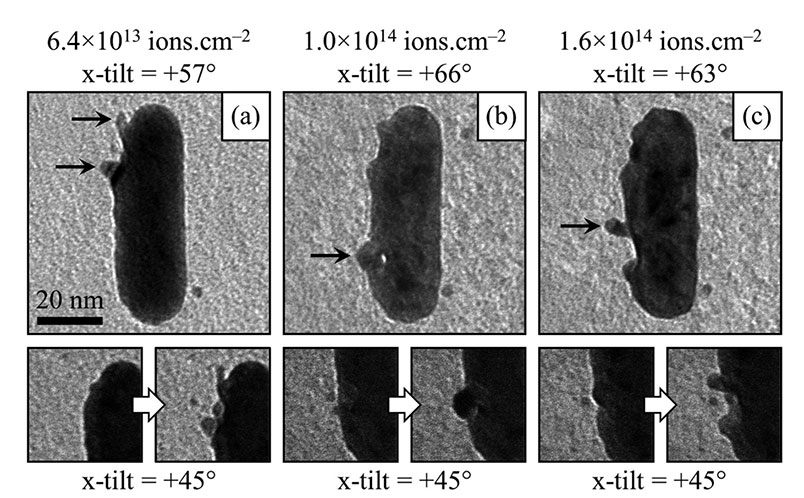In this research we explore the fundamental processes which take place when a single energetic particle impacts on nanostructures such as nanorods. The project combines experimental work at the MIAMI facility and at Sandia National Laboratories in the USA with computer modelling carried out by our collaborating partners at the University of Helsinki in Finland.
 Crater and ridge formed by single heavy-ion impact on Au: (a) transmission electron microscopy image; and (b) MD simulation.
Crater and ridge formed by single heavy-ion impact on Au: (a) transmission electron microscopy image; and (b) MD simulation.The modelling of atomic collision processes in solids as a sequence of isolated binary collisions works well in many circumstances but breaks down for collisions involving heavy ions, where the mean free path between successive collisions is of the order of (or smaller than) the interatomic spacing of the solid. In this case, a description in terms of “spike” processes is more appropriate. Rather than being envisaged as an orderly sequence of billiard-ball-type collisions, a spike process is more akin to a nanoscale meteorite impact in which a large amount of energy is deposited into a relatively-small volume resulting in an explosive response.
In our work, we have shown that single heavy-ion impacts in gold can create craters on surfaces and even punch holes through thin gold foils.
Because of the reduced dimensionality of nanorods, single-ion impacts can have similarly dramatic effects and, in particular, may result in the ejection of large amounts of material giving rise to large sputtering yields sometimes in excess of 1000 atoms for one ion impact.
In an ongoing collaboration with the University of Helsinki in Finland and Sandia National Laboratories in the USA, we are exploring this phenomenon over a range of energies and with different heavy ions. In recent experiments we have investigated the ions which pass through the nanorod without causing any damage. This is due to a phenomenon known as “channelling” in which the ions pass along open pathways in the crystal structure of the gold nanorods
 Crater and ridge formed by single heavy-ion impact on Au: (a) transmission electron microscopy image; and (b) MD simulation.
Crater and ridge formed by single heavy-ion impact on Au: (a) transmission electron microscopy image; and (b) MD simulation.Recent Publications
Effects of crystallographic and geometric orientation on ion beam sputtering of gold nanorods.
Hinks, J., Hibberd, . F., Hattar, K., Ilinov, A., Bufford, D. C., Djurabekova, . F., Greaves, G., Kuronen, . A., Donnelly, S. & Nordlund, K. 11 Jan 2018 In : Scientific Reports. 8, 10 p.
Sputtering yields exceeding 1000 by 80 keV Xe irradiation of Au nanorods
Ilinov, A., Kuronen, A., Nordlund, K., Greaves, G., Hinks, J. A., Busby, P., Mellors, N. J. & Donnelly, S. E. 15 Dec 2014 In : Nuclear Instruments and Methods in Physics Research, Section B: Beam Interactions with Materials and Atoms. 341, p. 17-21 5 p.
Enhanced sputtering yields from single-ion impacts on gold nanorods
Greaves, G., Hinks, J. A., Busby, P., Mellors, N. J., Ilinov, A., Kuronen, A., Nordlund, K. & Donnelly, S. E. 8 Aug 2013 In : Physical Review Letters. 111, 6, 065504
